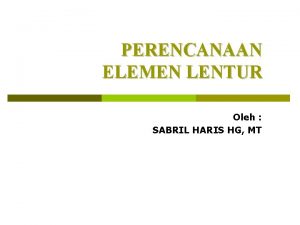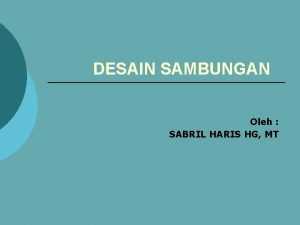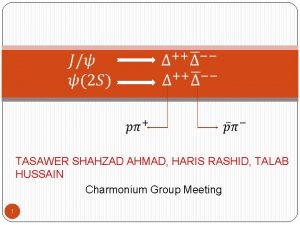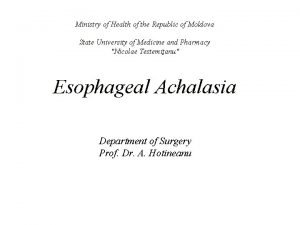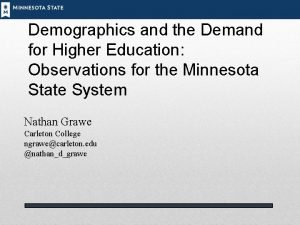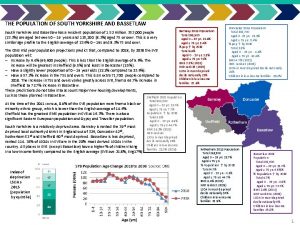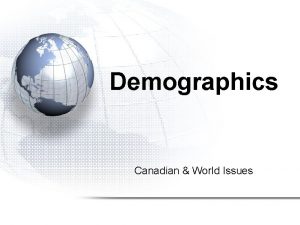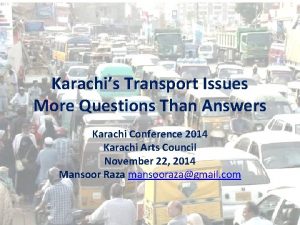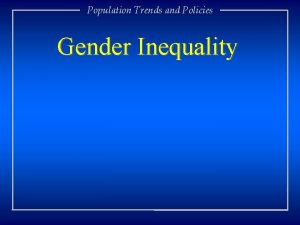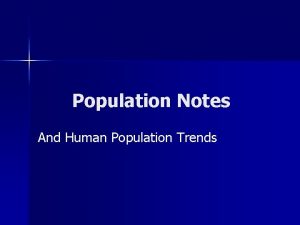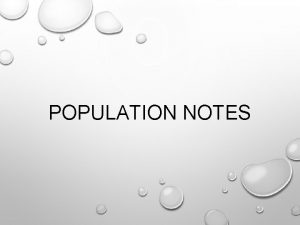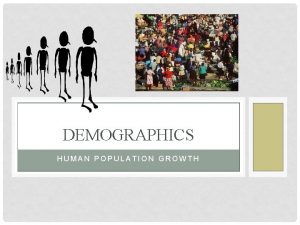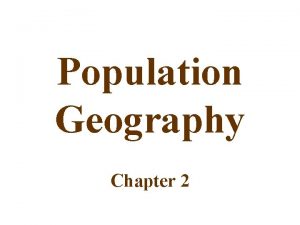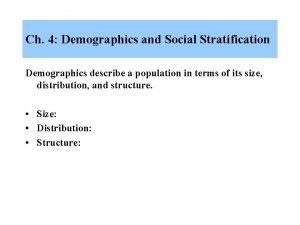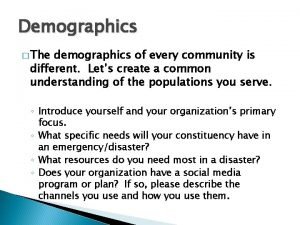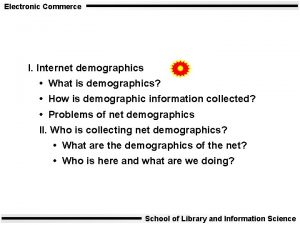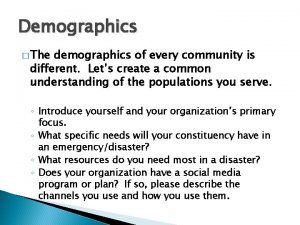Karachis Demographics and Politics Haris Gazdar Population trends
























- Slides: 24

Karachi’s Demographics and Politics Haris Gazdar

Population trends and projections - 1951 to 2025 25, 000 9 8 2025: 19. 5 m 20, 000 Total Population 7 15, 000 2011: 14. 25 m 4 10, 000 1998: 9. 86 m 5, 000 5 1961: 2. 04 m 1981: 5. 44 m 1972: 3. 61 m 0 3 percentage 6 Khi to Pakistan ratio Predicted Population 2 1 1953 1955 1957 1959 1961 1963 1965 1967 1969 1971 1973 1975 1977 1979 1981 1983 1985 1987 1989 1991 1993 1995 1997 1999 2001 2003 2005 2007 2009 2011 2013 2015 2017 2019 2021 2023 2025 0 Source: Author’s projections using population census data

Karachi’s population growth rate: historical and projected 0. 06 0. 05 0. 04 0. 03 Series 1 Linear(Series 0) 0. 02 0. 01 0 1967 1972 1977 1982 1987 1992 1997 2002

Migrants Population Census 1981, 1998 1981 Migrant as % of population From other country From KP/FATA From Punjab 1998 46. 1 23. 8 22. 2 7. 5 11. 3 5. 5 5. 0 6. 7

Urban and Rural Fertility Rates Source: Pakistan Demographic and Health Survey, 2006 -2007 and 2012 -2013 2006 -2007 2013 Major city Other urban All urban Rural All 3. 0 3. 8 3. 3 4. 5 4. 1 3. 2 4. 2 3. 8

Ethnic demography Distribution of population by reported mother tongue – Karachi and former districts in 1998 Karachi Central West East South Malir Urdu 49 74 40 61 26 16 Punjabi/ Seraiki 16 11 15 17 21 20 Pushto 11 5 25 6 8 21 Sindhi 7 2 6 4 11 25 Balochi 4 1 5 2 10 9 12 9 10 11 25 10 Other Source: Population Census 1998

Trends and projections of the city’s ethnic demography – 1981 to 2025 100% 11 90% 9 80% 70% 60% 5 6 12 11 4 13 14 14 16 4 7 4 8 15 16 9 17 50% 18 40% 30% 54 20% 49 44 40 10% 0% 1981 Urdu 1998 Punjabi/Siraiki 2011 Sindhi Balochi 2025 Pushto Others Source: Author’s projections using population census data

Assumptions behind ethnic projections Urdu Sindhi Punjabi/Siraiki Balochi Pushto Others Total 1981 - 1998 - 2011 - 2025 2. 87% 2. 20% 1. 70% 4. 40% 3. 90% 3. 20% 3. 96% 3. 50% 2. 60% 3. 00% 2. 50% 1. 90% 5. 23% 4. 40% 3. 30% 4. 40% 3. 40% 2. 70% 3. 56% 2. 95% 2. 33%

Localities, class and development interventions Literacy rate across Karachi and in former districts 100% 90% 80% 70% 60% 50% 40% 30% 20% 10% 0% Malir West Literacy Rate South East Central Karachi Average Source: Population census 1998

Availability of potable water, across Karachi and its former districts 100% 90% 80% 70% 60% 50% 40% 30% 20% 10% 0% Malir West South Potable Water East Central Karachi Average Source: Population census 1998

Literacy Rate gulberg shahfaisal n nazimabad jamshed malir liaquatabad sadar gulshan iqbal new karachi orangi korangi landhi lyari baldia gadap site kemari bin qasim Literacy rate across Karachi and its towns 100% 90% 80% 70% 60% 50% 40% 30% 20% 10% 0% Karachi Average Source: Population census 1998

Availability of potable water across Karachi and its towns Potable Water new karachi liaquatabad site n nazimabad shahfaisal gulberg gulshan iqbal lyari jamshed sadar landhi malir korangi gadap baldia bin qasim kemari 100% 90% 80% 70% 60% 50% 40% 30% 20% 10% 0% Karachi Average Source: Population census 1998

Literacy rates across Karachi and its UCs, highlighting District Central 100% 90% 80% 70% 60% 50% 40% 30% 20% 10% 0% Central Rest Karachi Average Source: Population census 1998

Potable water across Karachi and its UCs, highlighting District Central 100% 90% 80% 70% 60% 50% 40% 30% 20% 10% 0% Central Rest Karachi Average Source: Population census 1998

Percentage of circles according to literacy levels in North Nazimabad Town 100% 90% 80% circles (%) 70% 60% 50% 40% 30% 20% 10% 0% 1209 1203 1208 1206 1205 1201 1202 1210 1204 1207 UC High Medium Low Source: Population census 1998

Other critical division, less noticed Auhtors’ classification of Population Census 1998 units based on various sources Population Literacy share ratio Planned 44. 1 78. 5 Mixed 19. 1 66. 5 Unplanned 35. 9 52. 2 All 100. 0 65. 8 Homes with Homes water with connection electricity 85. 0 97. 6 75. 7 93. 5 61. 8 89. 4 74. 4 93. 8

Geography of planning Population Census 1998, authors’ calculation/classification All Karachi Planned 44. 1 Unplanned 35. 9 Mixed 19. 1 Central 72. 6 18. 4 8. 8 East 60. 6 19. 2 19. 6 South 29. 2 38. 5 31. 8 West 19. 8 57. 3 20. 0 Malir 10. 2 72. 7 17. 1

Literacy rates across Karachi and its charge circles, highlighting planned settlements 100 90 80 70 60 50 40 30 20 10 0 Planned Settlement Rest Karachi Average Source: Population census 1998

Potable water across Karachi and its charge circles, highlighting planned settlements 100% 90% 80% 70% 60% 50% 40% 30% 20% 10% 0% Planned Settlement Rest Karachi Average Source: Population census 1998

City politics Party vote share in Karachi MQM PPP PML ANP MMA/JUI PTI 1988 63 20 6 2 0 - 1990 71 16 7 2 0 - 1993 65 19 4 1 0 - 1997 56 10 22 1 0 - 2002 42 13 4 1 26 - 2008 68 22 4 2 1 - 2013 53 8 2 1 5 18 Source: Author’s calculations based on Dawn Election Data, compiled from Election Commission of Pakistan sources

MQM vote share in District Central and elsewhere in Karachi 1988 to 2013 100 90 80 70 60 50 40 30 20 10 0 Central All others Central All others 1988 1990 1993 1997 2002 2008 2013 Source: Author’s calculations based on Dawn Election Data, compiled from Election Commission of Pakistan sources

Distribution of polling stations – by vote share of winner and turnout rate Election Commission of Pakistan, authors’ calculation Proportion of all Vote share (per polling stations cent) (per cent) 50 or less 8. 1 50 to 60 7. 5 60 to 70 8. 3 70 to 80 10. 0 80 to 90 16. 3 90 to 95 15. 9 95 to 99 27. 5 Above 99 6. 5 Average turnout rate (per cent) 30. 7 31. 0 31. 8 35. 2 40. 4 51. 5 65. 4 70. 6

Political territory: polling stations 2008 Election Commission of Pakistan, authors’ calculations All Central East South West Malir All Karachi Planned and mixed MQM PPP 98. 6 1. 4 90. 9 6. 4 51. 7 46. 6 66. 2 26. 4 39. 0 61. 0 MQM 95. 3 85. 5 38. 2 48. 4 18. 3 PPP 4. 7 12. 3 54. 4 39. 1 78. 3 64. 1 31. 1 82. 3 15. 5 Unplanned MQM PPP 78. 3 21. 7 59. 9 39. 5 14. 2 68. 6 35. 7 47. 5 13. 9 81. 9 34. 3 56. 4

Dominated vs competitive polling stations by planning status – winning party secures 90% plus vote share Election Commission of Pakistan, authors’ calculation Competitive Planned and mixed Unplanned All 43. 6 60. 8 49. 9 Dominated 56. 4 39. 2 50. 1 No of PS 2, 144 1, 241 3, 385
 Haris wahyudi
Haris wahyudi Zafir rashid
Zafir rashid Sabril haris
Sabril haris Aleena haris
Aleena haris Hg elemen
Hg elemen Haris mouratidis
Haris mouratidis Design joints
Design joints Dr haris rashid
Dr haris rashid Haris vikalo
Haris vikalo Haralambos mouratidis
Haralambos mouratidis Dr haris manzoor qadri
Dr haris manzoor qadri Odybophagia
Odybophagia Presbydysphagia
Presbydysphagia Chapter 4 population ecology test answer key
Chapter 4 population ecology test answer key Section 1 population dynamics
Section 1 population dynamics Population ecology section 1 population dynamics
Population ecology section 1 population dynamics Population ecology section 1 population dynamics answer key
Population ecology section 1 population dynamics answer key Demographics and the demand for higher education
Demographics and the demand for higher education Swot analysis of forever 21
Swot analysis of forever 21 Walmart shopper profile
Walmart shopper profile Uf demographics
Uf demographics South yorkshire population
South yorkshire population Sfa demographics
Sfa demographics Causes of homelessness orange county
Causes of homelessness orange county Harvard demographics
Harvard demographics




